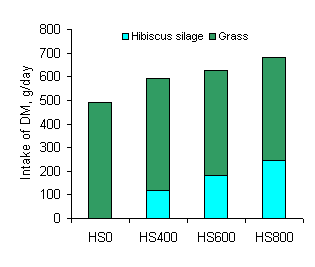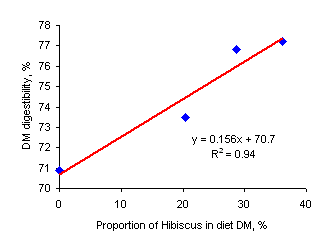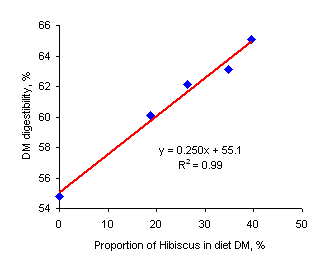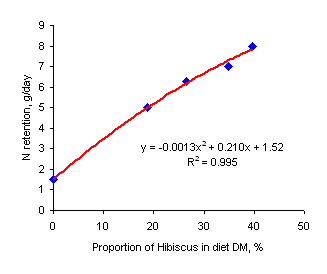The nutritive value of Hibiscus rosa siensis silage and the effect of supplement levels on
feed intake, digestibility, N-retention and rumen environment of
sheep and goats
Nguyen Xuan Ba, Vu Duy Giang, Le Duc Ngoan and Vu Chi Cuong
Hue University of Agriculture and Forestry
Hue, Vietnam
nthanhhuong@dng.vnn.vn
Abstract
Hibiscus rosa-sinensis L belongs to Malvacea family.
The farmers in central Vietnam mainly use it as a live fence
and ruminant feed. Due to high biomass yield (about 10 tonnes of DM
leaves/year/ha) and high crude protein content (17-21%), hibiscus
foliage could be a protein supplement source for ruminants. The
experiments aimed to evaluate nutritive value of Hibiscus
rosa-sinensis L and effect of supplemental levels of
Hibiscus rosa-sinensis L silage (HS) on DM intake,
digestibility, N retention and rumen environment of goats and
sheep. The nutritional values were evaluated in term of chemical
composition, in vitro gas production (GP) and were
calculated following the INRA system. The first experiments were
designed as a Latin square with 4 local growing goats with a mean live
weight of 15.3 kg. The treatments were (HS0) natural grass ad libitum (basal diet), (HS 0.4) basal diet plus 0.4 kg HS, (HS 0.6)
basal diet plus 0.6 kg HS and (HS 0.8) basal diet plus 0.8 kg HS.
The second experiment was designed also as a Latin square (5 x 5) with 5
local growing sheep with an average live weight of 17.4 kg. The
treatments were: (HS0) King grass ad libitum (basal diet),
(HS 400) Basal diet plus 400g Hibiscus rosa siensis foliage
silage, (HS 600) Basal diet plus 600 g HS; (HS 800) Basal diet plus
800 g HS and (HS 1000) Basal diet plus 1000 g HS.
The results from the experiment showed that the Hibiscus
rosa foliage silage had a high content of CP (20-21% in DM) and high
palatability for goats and sheep. Parameters of in vitro gas
production showed there was no difference between the sample with
or without addition of PEG. The gas volume at 48 hours after incubation was
46.5 and 46.6 ml in the sample without and with PEG,
respectively. The first experiment showed that there e
significant differences in DM intake, digestibility of
DM, OM and CP among the diets.
There was a trend to increasing intake and digestibility of goats
when increasing Hibiscus rosa silage in the diets up to 40%. There were no differences in
the goat's rumen environment between the
diets.
The results from the second experiment showed that ME and PDI
of Hibiscus foliage silage were 2738 kcal and 148 g per kg of DM,
respectively. The in vivo DM, OM and CP digestibility values of
Hibiscus foliage silage were 69.7, 73.1 and 84.4%,
respectively. There were differences in dry matter intake,
digestibility and N retention between treatments. The
determinant coefficients (R2)
between DM, OM, CP digestibility and percentage of Hibiscus foliage silage in
the ration were 0.43, 0.45 and 0.37, respectively. The N retention was increased when increasing Hibiscus foliage silage percentage in the diets.
The Hibiscus foliage silage could be a good
supplement as protein sources for ruminant.
Key words: chemical composition, digestibility,
gas production, goats, hibiscus rosa siensis, N- retention, PEG,
silage, sheep, supplement,
Introduction
Hibiscus rosa siensis L. belongs to the Malvacae family. The farmers in central Vietnam mainly use it as a live fence and ruminant feed. Hibiscus plants can grow very well in different kinds of soil and they can withstand hard conditions (hot weather and drought) in Central Vietnam (Nguyen Xuan Ba and Le Duc Ngoan 2003). The hibiscus leaves have high crude protein content (17-22% in DM) and high palatability for goats and sheep. Hibiscus can be planted by stem cuttings and it thus is easy to expand. In recent years, there has been some research on making silage of tree foliage (Nguyen Xuan Ba et al 2004a,b; Ojeda et al 2000). Sheep were used as the means for determination of in vivo digestibility because they have similar digestibility index with cattle (Aerts et al 1984).
Objectives:
-
To determine the nutritive value of Hibiscus rosa siensis foliage silage for growing goats and sheep.
-
To measure the effects of different amounts of Hibiscus rosa siensis foliage silage on the intake of a basal diet of grass and to estimate substitution rate of supplement for forage.
-
To measure the effects of different amounts of Hibiscus rosa siensis foliage silage on diet DM, OM and CP digestibility and rumen environment of goats.
Materials and methods
Location and feeds
The experiments were conducted from March to December 2003 in Hue University of Agriculture and Forestry (HUAF). The Hibiscus rosa siensis foliages were collected around Hue city and were ensiled with 5% of molasses. Native grasses were cut around Hue City. Elephant grass was harvested after re-growth period of 30-35 days in the HUAF farm.
Experiment 1: Effect of Hibiscus rosa siensis silage levels in the diet on feed intake, digestibility and N-NH3 content in the rumen fluid of goats
Experimental design and animals
Four local growing goats with average body weight of 17.4 kg were used to study the feed intake, total tract digestibility and N-retention of the diets. The experiment was designed as a 4x4 Latin square. Each period lasted 15 days, in which 10 days were for adaptation, 5 days for data collection. The diets were native grass (NG) (basal diet) (HS0), basal diet plus 400 g/day Hibiscus rosa siensis foliage silage (HS400), basal diet plus 600 g/day Hibiscus rosa siensis foliage silage (HS600), basal diet plus 800 g/day Hibiscus rosa siensis foliage silage (HS800). Water and salt were freely available for all animals. Feeding was 4 times per day at 8, 11, 14 and 17 o'clock. The animals were kept in digestibility cages in order to collect the samples of faeces.
Experiment 2: Effect of Hibiscus rosa siensis silage levels in the diets on feed intake, digestibility
and N-retention of sheep.
Five local growing sheep with average body weight of 15.3 kg were used to study the feed intake, rumen environment and total tract digestibility of the diets. The experiment was designed as a 5 x 5 Latin square. Each period lasted 16 days, in which 10 days were for adaptation, 5 days for data collection and day 16 for taking the sample of rumen fluid. The diets were Elephant grass (basal diet) (HS0), basal diet plus 400 g/day Hibiscus rosa siensis foliage silage (HS400), basal diet plus 600 g/day Hibiscus rosa siensis foliage silage (HS600), basal diet plus 800 g/day Hibiscus rosa siensis foliage silage (HS800) and basal diet plus 1000 g/day Hibiscus rosa siensis foliage silage (HS1000). Water and salt were freely available for all animals. Feeding was 4 times per day at 8, 11, 14 and 17 o'clock. The animals were kept in digestibility cages in order to collect separately the samples of faeces and urine.
Sample collection
Hibiscus rosa siensis foliage samples were collected from the HUAF farm after re-growth of 10 weeks, chopped into small pieces, dried in an oven at 60°C and then ground for gas production analysis.
Feed offered and refused, and output of faeces and urine, were recorded daily during the last 5 days of each period. Samples of feed offered and refusals were taken daily and analyzed for DM and N
Faeces were collected every 2 hours and put in polyethylene bags and stored at 4 ºC. At the end of each period the total amount of faeces were mixed and a sub-sample (about 10%) was then dried at 60ºC for chemical analysis. Rumen fluid was taken by stomach tube 4 hours after feeding on day 16. At each time, about 20 ml of rumen fluid were obtained. 10% of solution of 20 % H2SO4 was added to halt the fermentation. Urine were immediately collected after urinating, added 10% of solution of 20 % H2SO4 and then stored at -200C . At the end of each period all the urine of each animal was mixed well and 10 % of sub-sample taken for chemical analysis.
Measurements and chemical analysis
Total N of feed, faeces and urine and N-NH3 of feed
and rumen fluid were measured by the Kjeldahl procedure as outlined
by the AOAC (1990). The ash content of feed and faeces was
determined following the AOAC (1990) recommendations. Organic
matter was assumed to be the result of subtracting the percentage
of ash from 100. pH was determined by glass electrode measurements
in a digital pH meter. Gas production was determined following the in vitro procedure
of Menke and Staingass (1988).
The digestibility of Hibicus rosa foliage silage in the in vivo experiment was calculated following the equation:

Where:
Z : Digestibility for DM, OM and CP of HS (%)
Y: Digestibility for DM, OM, CP of diet which contained HS
(%)
X: Digestibility for DM, OM, CP of elephant grass (%)
a : percentage of grass in the diet based DM; OM or
CP
b :percentage of hibiscus rosa foliage silage in the diet based DM; OM or CP
Biometrical analysis
The data were analyzed according to the analysis of variance technique using the general linear model (GLM) procedure in the software of MINITAB version 13 The mathematical model used was:
Yi jk = M + Pi + Aj + T(i
j),K + Ei jk
Where:
Yi jk : Independent variable (intake, apparent
digestibility....)
M: Overall mean
Pi: Effect of period
Aj:: Effect of goats
Tk: Effect of treatments
Ei jk: Effect of random error
Results and discussion
Gas production of Hibiscus rosa siensis foliages
Gas volumes and gas production indices from 200 mg DM of Hibiscus rosa siensis foliage samples with and without PEG are shown in Table 1.
|
Table 1: Gas volumes and gas production indices from 200 mg DM of Hibiscus rosa siensis foliage (ml) |
|||||||||
|
|
Incubation time (hour) |
Indices |
|||||||
|
3 |
10 |
24 |
48 |
72 |
96 |
a |
b |
C |
|
|
HF |
4.44 |
20.9 |
40.4 |
46.5 |
48.2 |
48.4 |
-7.07 |
55.6 |
0.074 |
|
HF+PEG |
4.13 |
20.7 |
40.5 |
46.6 |
48.2 |
48.5 |
-7.58 |
56.2 |
0.074 |
There were no significant differences in
gas volume and gas production indices between samples with and without
PEG. This means that the tannin content in HF did not affect gas
production and the fermentation rate in the in vitro experiment.
Experiment 1: Effect of Hibiscus rosa siensis silage levels in the diets on feed intake, digestibility and N-NH3 content in the rumen fluid of goats
Data on the composition of the silage and the grass are in Table 2. The pH of 4.5 in the silage indicates a satisfactory fermentation
|
Table 2: Chemical composition of the Hibiscus silage and the grass in experiment 1 (% in DM except for DM which is % as fresh matter) |
|||||
|
|
DM |
OM |
CP |
Ash |
pH |
|
Hibiscus silage |
36.2 |
81.2 |
19.9 |
18.8 |
4.45 |
|
Native grass |
20.1 |
82.4 |
11.6 |
17.6 |
- |
DM intake increased linearly as the proportion of
hibiscus silage in the diet increased
up to 36% of the diet DM (Table 3; Figure 1)


Figure 1: Relative intakes of grass and Hibiscus silage by goats fed different levels of the silage
Diet digestibility increased as the proportion of Hibiscus silage in the diet increased (Table 3; Figure 2). It can be predicted from the regression equation that a diet with 100% hibiscus silage would have a DM digestibility of 86.3%.

Figure 2: Effect of level of Hibiscus silage on DM digestibility
|
Table 4: Mean values for effect of offer levels of Hibiscus silage on the digestibility (%) of DM, OM and CP by goats |
||||||
|
|
Diets |
SEM |
P |
|||
|
HS0 |
HS400 |
HS600 |
HS800 |
|||
|
DM |
70.9a |
73.5ab |
76.8b |
77.2b |
0.6 |
0.012 |
|
OM |
74.3a |
77.0ab |
80.4b |
80.3b |
0.6 |
0.012 |
|
CP |
73.1a |
78.3ab |
80.6ab |
81.7b |
1.2 |
0.036 |
|
abcd Means within rows without common letter are different at P<0.005 |
||||||
There were no effects of increasing levels of hibiscus silage on rumen pH or ammonia concentration ((Table 5). The latter appeared to be very high on both the control and Hibiscus diets.
|
Table 5: Mean values for effect of offer levels of Hibiscus silage on rumen ammonia and pH |
||||||
|
|
Diets |
SEM |
P |
|||
|
HS0 |
HS400 |
HS600 |
HS800 |
|||
|
pH |
6.67 |
6.74 |
6.66 |
6.71 |
0.02 |
0.197 |
|
N- NH3 (mg/litre) |
302 |
394 |
405 |
317 |
58.9 |
0.620 |
Experiment 2: Effect of Hibiscus rosa siensis silage levels in the diets on feed intake, digestibility and N-retention in sheep.
Crude fibre levels were almost twice as high in the elephant grass as in the Hibiscus silage, the latter also having a higher content of crude protein and of ether extract (Table 6). In this experiment, the digestibility values were calculated by the "difference" method (see Materials and Methods for the calculation), which assumes there is no interaction between the two diet ingredients. According to this procedure the DM digestibility was only 69.8% whereas when calculated by regression in Experiment 1, the value was estimated to be much higher (86.3%). The latter value would appear to be the more appropriate one.
|
Table 6: Mean values for chemical composition of feeds and digestibility coefficients |
|||||
|
|
DM |
OM |
CP |
CF |
EE |
|
Composition, % in DM (except for DM which is on fresh basis) |
|||||
|
Hibiscus silage |
29.2 |
89.8 |
21.1 |
17.0 |
5.05 |
|
Elephant grass |
12.9 |
88.4 |
15.2 |
30.6 |
2.51 |
|
Digestibility coefficients, % |
|
|
|
||
|
Hibiscus silage |
69.8 |
73.1 |
84.4 |
|
|
|
Elephant grass |
54.8 |
58.9 |
65.3 |
|
|
The effects on feed intake of the sheep (Table 7; Figure 3) and on digestibility (Table 8; Figure 4) by offering increasing level of Hibiscus silage was similar to that observed with goats in Experiment 1.
|
Table 7. Mean values for effect of offer level of Hibiscus silage on feed intake by sheep |
|||||||
|
|
Diets |
SEM |
Prob. |
||||
|
HS0 |
HS400 |
HS600 |
HS800 |
HS1000 |
|||
|
Percentage of HS in diets (%) |
0.0 |
18.7 |
26.4 |
34.8 |
39.6 |
0.56 |
0.001 |
|
Protein content (% DM) |
15.2 |
16.3 |
16.8 |
17.3 |
17.5 |
0.03 |
0.001 |
|
Feed DM intake (% of LW) |
2.9a |
3.1 ab |
3.3 b |
3.3 b |
3.5 b |
0.09 |
0.002 |
|
abcd Means within rows without common letter are different at P<0.005 |
|||||||

Figure 3: Relative intakes of Elephant grass and Hibiscus silage by sheep fed different levels of the silage
|
Table 8. Mean values for effect of offer level of Hibiscus silage on digestibility coefficients (%) for DM, OM, and CP by sheep given basal diet of Elephant grass |
|||||||
|
|
Diets |
SEM |
Prob. |
||||
|
HS0 |
HS400 |
HS600 |
HS800 |
HS1000 |
|||
|
DM |
54.8a |
60.1 b |
62.1 bc |
63.1 bc |
65.1 c |
0.97 |
0.001 |
|
OM |
59.0a |
63.4 b |
65.2 bc |
66.2 bc |
68.3 c |
0.89 |
0.001 |
|
CP |
65.3a |
70.6 b |
70.1 b |
72.1 b |
73.9 b |
0.83 |
0.001 |
|
abcd Means within rows without common letter are different at P<0.005 |
|||||||
When the regression equation in Figure 4 is used to predict the digestibility of the Hibiscus silage (eg: when x = 100), the estimated value is 80.1%, which is not so different from the value calculated for Hibiscus silage fed to goats (86.3%) using the regression in Figure 2.

Figure 4: Effect of level of Hibiscus silage on DM digestibility in sheep
The data on N balance of the sheep in Table 9 indicate that almost all the additional nitrogen consumed (an increase of 50% from the diet without Hibiscus silage to the diet containing 40% of the silage) was retained as there were no significant increases in faecal or urine N (Table 9). There was a curvilinear relationship (R2 = 0.995) between the proportion of Hibiscus silage in the diet and the retention of nitrogen (Figure 5).
|
Table 9. Mean values for effect of offer level of Hibiscus silage on N balance in sheep given basal diet of Elephant grass |
|||||||
|
|
Diets |
SEM |
Prob. |
||||
|
HS0 |
HS400 |
HS600 |
HS800 |
HS1000 |
|||
|
N balance, g/day |
|
|
|
|
|
||
|
Intake |
14.2 |
17.2 |
18.6 |
19.3 |
21.6 |
0.35 |
0.001 |
|
Feaces |
4.8 |
4.9 |
5.6 |
5.3 |
5.5 |
0.21 |
0.065 |
|
Urinary |
7.9 |
7.3 |
6.8 |
7.0 |
8.0 |
0.54 |
0.440 |
|
Retention |
1.5 a |
5.0 b |
6.3 bc |
7.0 bc |
8.0 c |
0.60 |
0.001 |
|
Retention as % of intake |
8.3 a |
27.4 b |
35.4 b |
32.3 b |
36.9 b |
3.19 |
0.001 |
|
abd Means within rows without common letter are different at P<0.005 |
|||||||

Figure 5: Effect of level of Hibiscus silage on N retention in sheep
Conclusions
-
Hibiscus rosa siensis foliage can be ensiled satisfactorily with addition of 5% molasses(W/W).
-
Goats and sheep fed a basal diet of native grass or elephant grass responded with a linear increase in voluntary intake and DM digestibility as the offer level of Hibiscus silage increased up to 40% of the diet DM.
-
There was a curvilinear increase in N retention with increasing level of Hibiscus silage in sheep fed a basal diet of Elephant grass
References
Aerts J V, De Boever J
L, Cottyn B G, De Brander D L and Buysse F S 1984
Comparative digestibility of feedstuffs by
sheep and cows. Anim. Feed Sci. Technol. 12: 47.
AOAC 1990 Association of Official Analytical Chemists,
Official methods of Analysis, 15th edn. Vol 1. AOAC.
Washington, DC.
Dinh Van Cai 2004
Discussion on ruminant nutritive
research strategy in the future in Vietnam. Vietnamese Science
& Technology Journal of Animal production 8 (66),
pp 27-29.
Menke K H and Staingass H 1988 Estimation of the
energetic feed value obtained from chemical analysis and in vitro
gas production using rumen fluid. Anm.Res. Develop.28:
7-55
Nguyen Xuan Ba and Le Duc Ngoan 2003 Evaluation of some
unconventional trees/plants as ruminant feeds in Central Vietnam.
In: Proceedings of Final National Seminar-Workshop on
Sustainable Livestock Production on Local Feed Resources (Editors:
Reg Preston and Brian Ogle). HUAF-SAREC, Hue City, 25 - 28 March,
2003. Retrieved , from http://www.mekarn.org/sarec03/bahue.htm
Nguyen Xuan Ba, Vu Duy Giang and Le Duc Ngoan 2004a Effect of different additives on quality of mulberry foliage silage. Vietnamese Science & Technology Journal of Agriculture & Rural Development 7, 990-991.
Nguyen Xuan Ba, Vu Duy Giang, Le Duc Ngoan and Vu Chi
Cuong 2005: The nutritive value of Hibiscus rosa siensis
silage and the effect of supplement levels on
feed intake, digestibility, N-retention and rumen environment of
sheep and goat
Nguyen Xuan Ba, Vu Duy Giang
and Le Duc Ngoan 2004b
The use of Hibiscus Rosa Siensis L. for Goats. Vietnamese
Science & Technology Journal of Agriculture & Rural
Development 9, 1199-1201.
Ojeda F., Montejo I and Guadalupe Pe'rez (2000)
Conservation of Mulberry as silage. FAO Animal Production and
Health Paper 147, FAO, Rome
.